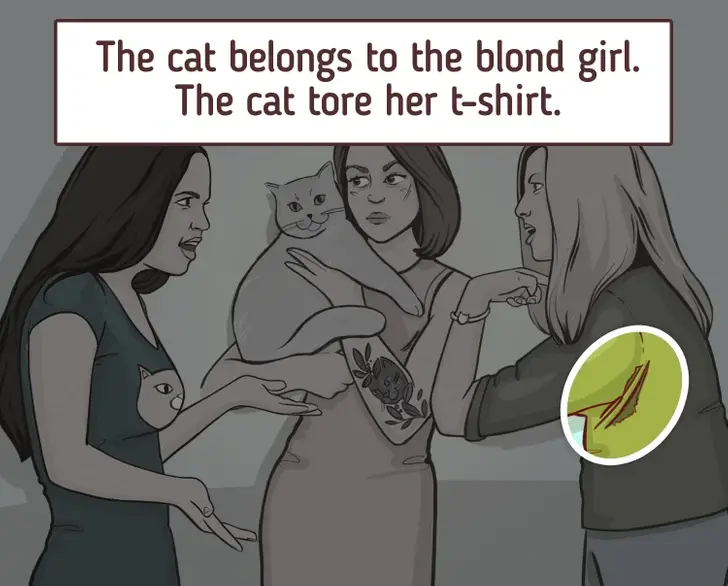In today’s brain-teaser, we’ve got a unique puzzle to solve! Three women are disputing the ownership of an adorable cat. Each one insists the feline belongs to her, but a careful observation of the image will reveal the real owner. Think you can spot the telltale clue? Let’s dive in and uncover the truth!
Why Visual Puzzles Are Trickier Than They Seem

Our brains love shortcuts, especially when it comes to visual information. When presented with puzzles like this, we often make assumptions based on obvious signs, like who’s holding the cat or who appears the most affectionate toward it. However, these types of clues can lead us astray. Our minds are naturally inclined to overlook tiny details that could provide the key to solving the mystery.
In this case, while you may be tempted to focus on the woman holding the cat or the one with the cat tattoo, the actual answer is hidden in a subtler clue. Let’s take a closer look.
Common Mistakes in Solving Ownership Puzzles
When trying to deduce who the cat’s true owner is, people often make the following mistakes:
- Relying on the Obvious: Many assume the person physically holding the cat is the owner, but this assumption can mislead us.
- Overlooking Minor Clues: Subtle hints, like a torn shirt or scratch marks, are often ignored, yet they could be the clearest signs of ownership.
- Basing Decisions on Appearance: Tattoos, expressions, and clothing might imply familiarity with cats but don’t necessarily indicate ownership.
These common errors make it difficult to arrive at the correct answer. To solve this puzzle, we need to examine each clue methodically.
Breaking Down the Puzzle: Who’s the Real Owner?
To solve this mystery, let’s consider each woman’s appearance and actions to see if we can determine ownership.
1. The Woman Holding the Cat
- At first glance, it’s tempting to assume she is the owner. After all, she’s the one holding the cat, which seems like an act of ownership.
- However, her posture doesn’t necessarily confirm she’s the owner. It’s possible she picked up the cat simply to calm it or hold it away from the others.
- Relying solely on the fact that she’s holding the cat isn’t enough to establish ownership.
2. The Woman with the Cat Tattoo
- This woman has a tattoo of a cat on her arm, suggesting she’s a cat lover and possibly the owner. However, owning a tattoo doesn’t prove ownership of the specific cat in question.
- While her tattoo may suggest she likes cats, it’s also possible she admires them generally but doesn’t own this one.
- This detail could be a red herring designed to lead you astray.
3. The Blond Woman with the Torn Shirt
- Finally, let’s observe the woman on the right, the one with the blond hair. Upon closer inspection, you’ll notice that her shirt has a visible tear.
- This tear is the most revealing clue, as it likely resulted from a recent interaction with the cat—perhaps the cat scratched or clawed her while being held.
- The tear strongly suggests the cat is hers, as cats often scratch or tear clothing when they’re picked up or feel restless in the arms of their owner.
Conclusion: The True Owner of the Cat
After examining each detail, the answer is clear: the blond woman with the torn shirt is the cat’s true owner. The tear on her shirt indicates she recently held the cat, and the cat may have accidentally scratched or torn her shirt in the process. This clue is far more telling than holding the cat or having a tattoo, making her the most likely owner.

Why Observing Details Is Key to Solving Visual Puzzles
Visual puzzles like these teach us the value of observing details rather than relying on immediate impressions. Often, the smallest clue can make all the difference, helping us solve mysteries that seem puzzling at first. When we focus on details rather than assumptions, we train our brains to think critically and notice hidden connections.
Share the Puzzle and Challenge Your Friends
Did you figure out the answer on your own? Comment below and let us know! Visual puzzles like this one are a fun way to challenge yourself and enhance your observational skills. If you enjoyed solving this, share it with friends or family and see if they can spot the clue too. It’s a great way to test their attention to detail!
Final Thoughts: Keep Practicing and Mastering Visual Puzzles
Solving puzzles like this is more than just a fun pastime; it’s an exercise in sharpening your mind and improving your ability to notice details. As you continue to tackle visual puzzles, you’ll become quicker at spotting the subtle hints and hidden connections that others might miss. So keep challenging yourself with more puzzles, stay observant, and enjoy the satisfaction that comes from uncovering the answers.
Happy puzzling, and remember—sometimes, the smallest details reveal the biggest truths!